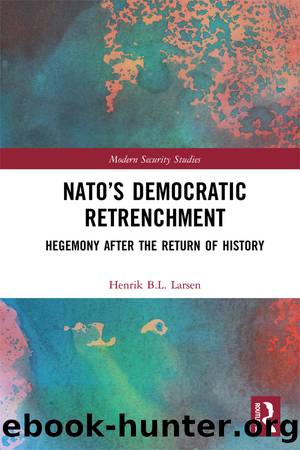Nato's Democratic Retrenchment: Hegemony After the Return of History by Henrik Larsen

Author:Henrik Larsen [Larsen, Henrik]
Language: eng
Format: epub
Tags: Political Science, Intergovernmental Organizations, General
ISBN: 9780429999680
Google: Ns6gDwAAQBAJ
Goodreads: 44325784
Publisher: Routledge
Published: 2019-07-02T00:00:00+00:00
8.2 Conclusion
The analysis proceeded along the three-levelled neoclassical realist sequencing explaining NATOâs democracy support in the Western Balkans (y) resulting from the constraints and impetuses of Russiaâs regional leverages (x) as mediated by the predominant understandings of Europeâs unification (z). The parliamentary ratifications of the accession of Albania, Croatia and Montenegro revealed useful information about the details of the national cost/benefit concerns at play, while confidential/leaked sources proved useful in tracing the negotiations among allies otherwise not available to the public.
The collapse of regional order in the 1990s was a vivid demonstration of the importance of U.S. determination to enforce peace, followed by NATO peacekeeping to establish a new order and maintain it by means of security policy integration. NATOâs advance was explained as a point of departure from the âtemptationâ to support democratic improvement (Croatia, Albania) within the constraints of Russiaâs successful conflict perpetuation (Belgrade-Kosovo, Sarajevo-Srpska) but unfettered by its attempts to promote energy dependency and in fact reinforced by its undeclared, subversive acts against domestic-political processes to strengthen anti-NATO segments (North Macedonia, Montenegro). Power constraint is best described not as a static power vacuum but as a dynamic concept that stimulates policy expansion or retrenchment. In contrast to Georgia and Ukraine, Russia stands out as a contributing, but not a root, cause. Conflict perpetuation successfully impeded Euro-Atlantic integration, whereas subversion had the opposite effect and compelled NATO to âclose the gapâ. Crude power shifts can explain âemptyâ balancing behaviour within a given spatial constraint but fall short of explaining the tactical disagreements about values-based security integration.
Clear historical analogies drive both the United States and Germany to take a strong interest in the inclusion of the West Balkan countries, but the difference in lessons explains why the former saw NATO as a democratic umbrella for ethnic reconciliation and statebuilding, whereas the latter preferred an approach of restraint with NATO as a âfirst-waveâ democratiser. Vague analogies applied for France, the United Kingdom and partly Poland, which caused preferences, respectively, for a stable periphery of the concentric Europe, instinctive balancing with continued U.S. involvement, and asserting NATOâs Open Door.
NATO did not face significant trade-offs between democratisation objectives as a long-term endeavour (with uncertainty about outcome, time delay and free/easy riding as described in chapter 1) and security concerns to be dealt with in the short term. This leaves a great deal of autonomy to geopolitical lessons in the establishment of national priorities, even for states where the lessons were vague. Lessons were a reinforcing factor for the United States, the United Kingdom and Poland, which tended to look at problematic nationalistic legacies as something to be overcome and from which Russia should be marginalised. Lessons were a constraining factor for Germany and France, which were more cautious, implicitly seeking a balance of interest with Russia and biased toward the EU as the core integration project.
The inclusion of geopolitical lessons at the unit level gives insight into hegemonyâs motivational aspects: the United States, driven by its domestic considerations in favour of the
Download
This site does not store any files on its server. We only index and link to content provided by other sites. Please contact the content providers to delete copyright contents if any and email us, we'll remove relevant links or contents immediately.
| Automotive | Engineering |
| Transportation |
Machine Learning at Scale with H2O by Gregory Keys | David Whiting(3984)
Never by Ken Follett(3715)
Urban Outlaw by Magnus Walker(3310)
OPNsense Beginner to Professional by Julio Cesar Bueno de Camargo(3230)
Sapiens and Homo Deus by Yuval Noah Harari(2951)
Will by Will Smith(2745)
A Short History of Nearly Everything by Bryson Bill(2585)
Hooked: A Dark, Contemporary Romance (Never After Series) by Emily McIntire(2470)
Rationality by Steven Pinker(2235)
Borders by unknow(2155)
Holy Bible (NIV) by Zondervan(2059)
The Becoming by Nora Roberts(2038)
The One Percenter Encyclopedia by Bill Hayes(1763)
Freedom by Sonny Barger(1747)
HBR's 10 Must Reads 2022 by Harvard Business Review(1744)
A Short History of War by Jeremy Black(1732)
Five Ways to Fall by K.A. Tucker(1668)
Girls Auto Clinic Glove Box Guide by Patrice Banks(1657)
Go Tell the Bees That I Am Gone by Diana Gabaldon(1655)
